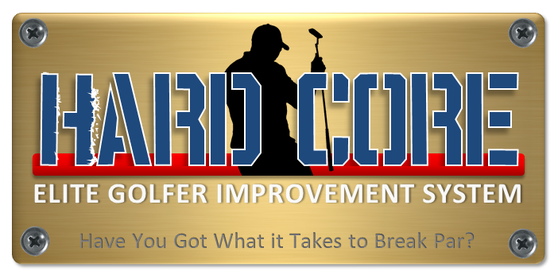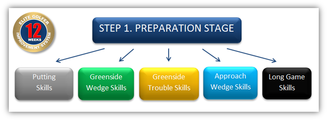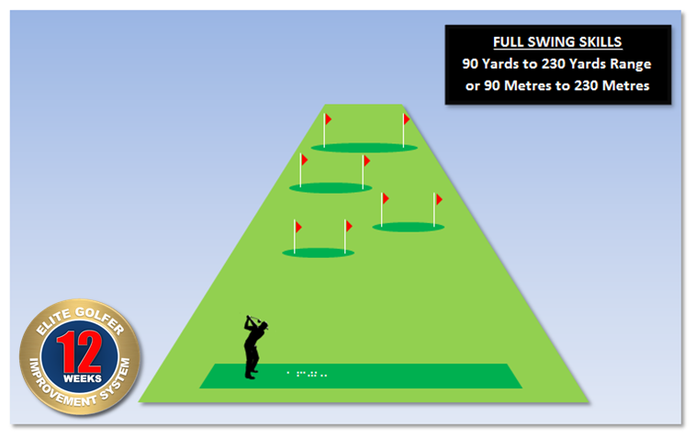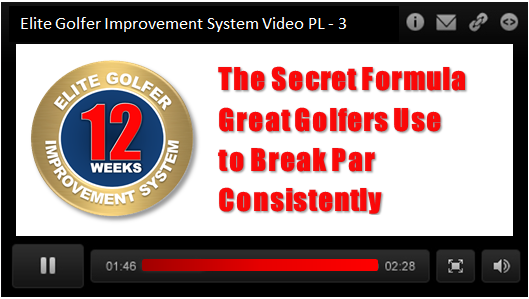 A very common question that both David and I have been asked many times over the years (particularly of recent years) from serious golfers and their parents goes something like this; “if you’re a low handicap golfer how should you practice if you want to be a pro golfer?” What a great question. How should you practice if you’re an elite golfer who wants to become a top class amateur or even a successful professional golfer? Our answer is simple; you have to practice so that the end result is a competitive score average that is under par. David and I have performed a reasonable amount of inquiry into this question and that answer and we find very little in the way of information that can help an elite golfer to keep on improving their game-especially when they start to get close to par. There are a few articles on the internet that focus on helping golfers to break 80 by well-known golf magazines, and a few blog entries, but not much more than that. There is nothing of substance that focuses on helping elite golfers learn how to practice so they can break par on a consistent basis. To be honest we were quite surprised to discover how little golf instruction content is focused on elite golfer development online. That is apart from our weekly entries here at our blog at www.protourgolfcollege.com. So the next common-sense step for David and I was to conceive and then develop a comprehensive online elite golfer improvement program for serious amateur and professional golfers to drive their golf scores consistently into the red figures. We started developing the program that you are about to learn about by establishing some ground rules.
The last one should be obvious, but in our experience one of the problems with many of the self-development programs marketed on the internet is that they don’t provide a step-by-step approach. They give you a lot of content to satisfy the price they charge and then ask you to figure out how to make it work for you. One thing you can be sure of is that our new program is based on our experience working with elite golfers at our golf college and our program is more of a system than it is a program. We have gone through the trial and error of developing our program and our goal was to develop a system of steps that guide you to lower golf scores. Our new program is called Hard Core - Elite Golfer Improvement System (E.G.I.S) It is built upon a 4 step practice and performance structure that you use over 12 weeks that will guide you step-by-step through your practice sessions teaching you how to practice so you can learn how to break through to lower golf scores. The EGIS is a home based golf training program for serious (hard core) advanced golfers who want to become elite amateur golfers or professional golfers. Before You Read On… We don’t like to disappoint any golfer if we can help it, but we want to say right from the outset that this program will not suit male and female golfers who don’t like to practice, or who practice less than two hours per week outside of playing on the golf course. You have to put the practice hours in to benefit from this program, especially to become a red zone golfer (more about that later on).  That’s the reason we call it hard core. The only golfers who will truly benefit from this golf training system are golfers who; a) Can finish what they start b) Who don’t get distracted easily c) Who can focus on long term development and improvement This means that it will suit serious - hardworking elite junior and senior golfers of any age who truly want to learn how to greatly improve their golf skills and learn how to play good enough to break par consistently. This might seem like a bold and audacious statement but we're coming from a position of experience having witnessed many fine golfers come to a roadblock in their career where they don't know how to take their game to the next level and this is exactly where we focus our program. It also might seem strange that we wouldn't want every good golfer to use our new program but quite frankly unless you’re willing to put in the hard yards this golf improvement program won’t help you. No program will! Our Proven Methodology The great thing about this new program is that the practice routines and golf training methodology you will learn and use has been developed, testing, measured against thousands of the golf shots of our students in our full time program at Pro Tour Golf College. How many elite golf improvement programs can actually say that?  Let me show you through the EGIS program and you’ll quickly realize that this is a unique and comprehensive golf improvement program answers many of the questions that we have been asked by elite golfers about breaking scoring barriers. Step 1. Preparation Phase: 5 Core Golf Skills The EGIS program has been designed to guide you through the steps required to build a high performance golf practice program that will help you to learn how to break par on a consistent basis. Do you realize that the top professional golfers average around 12 pars in each round, 3 to 4 birdies and keep the bogeys down to less than 3? Our program has been designed to help you to;
Have you ever heard the quote "Victory Loves Preparation?" The first important step in the EGIS program is called the preparation stage which is where you go through a thorough process of assessing your 5 core golf skills so you can build a profile of your strengths and weaknesses. This part of the program is the most important and time consuming because you have to assess your core golf skills in a very precise way and it is the beginning of the journey to lower golf scores. You can see from the image below of the system that there are 5 core golf skills (grey, green, orange, blue and black) that we will focus on in this program. Within these core golf skills are the skill sub sets which are the actual golf skills that you will assess, develop and improve. When you think of the skill sub sets we want you to think of how they influence your golf scores in a positive way when you improve them. What we mean is that these golf skills influence more pars, birdies and bogeys or less depending on how capable you are in executing them. Here are what we call the defense skills and producer skills that you will identify and improve in your game to produce lower golf scores. 1. Par Defense Skills 2. Par Producer Skills 3. Birdie Producer Skills 4. Bogey Defense Skills Putting Skills Assessment – Par Defense Skills / Birdie Producer Skills To start with we want to know how good a putter you are on all types of putts from short through to long. Are you better putter on right-to-left putts from 3 feet or left-to-right putts from 6 feet? Do you know? So you will assess your short putting skills (grey color zone) from 3 feet to 12 feet (1 metre to 4 metres). Your putts are assessed from all types of angles to determine just how effective you are with a putter from this critical range. The best golfers are great putters and we have found that besides working on perfecting your stroke if you don't practice your putting skills so that you condition your nervous system to manage the normal stress associated with tournament play then it doesn't matter how good you stroke your putts, you'll miss many more than you make. ****************************************************************************************************************************************** Here's a Good Tip: Always practice your short putting as if each putt really mattered. On the PGA Tour the best putter inside 10 feet was Luke Donald in 2012 who made 761 putts from 844 attempts which translates to an amazing 90.17 percent of putts made from this distance range. ****************************************************************************************************************************************** Once we know how good a short putter you are, you can learn how to practice to become a great short putter just like Luke Donald. Long Putting Skills Assessment – Par Defense Skills Next we need to know how good you are from long distances from 15 feet to over 42 feet from the hole. Great putters rarely 3 putt and from this distance range you have to be able to get your putts close enough to the hole to make the next one. ****************************************************************************************************************************************** Here's a Good Tip: If you want to find out how good a long putter you are count your 3 putts up over your last 10 rounds of golf and divide them by the total amount of holes you played to see how good your long putting is. For example 12 - 3 putts divided by 180 holes = 6.66%. On the PGA Tour in 2012 Brian Gay was the best at 3 Putt Avoidance with just 24 - 3 putts for the 1,566 holes he played which is a very low 1.53 percent. ****************************************************************************************************************************************** It might surprise you to know that long putting is rarely practiced enough by aspiring golfers and yet by learning how to roll your ball correctly over the 15 to 42 feet distance range you will lower your golf scores. In your long putting assessment you will putt from various distances and determine how likely you're to three putt or two putt. Greenside Wedge Skills Assessment – Par Defence Skills The next area to assess is your greenside wedge skills. This is your chipping, pitching and bunker skills within 30 yards of the edge of the green surface. We’ll show you how to assess these important skills and determine which of them needs more attention. These skills are your par saving skills and as such require constant attention to become a golfer who can break par on a regular basis. ****************************************************************************************************************************************** Here's a Good Tip: When you practice your greenside skills practice from as many different places as possible around the green and make sure that you practice from uneven lies as many elite golfers we have observed practice mostly from level lies. On the PGA Tour in 2012 Brian Gay was the best at defending par around the green with par or better 376 times from 584 attempts which translates to 64.38 percent. ****************************************************************************************************************************************** Greenside Trouble Shots Assessment – Bogey Defence Skills The following skills are rarely practiced and yet you’re confronted with trouble shots in most of your rounds of golf. Bad lies in the grass and bunker and high flying soft landing lob (flop) shots to tight pins are skills that you need to improve to turn potential bad scores into good ones. When you miss your approach shots in the wrong place you have to rely on your greenside trouble skills to get you out of trouble and back into the game. ****************************************************************************************************************************************** Here's a Good tip: When you practice greenside skills make sure you spend a minimum of fifty percent of your practice hitting shots from tough lies like half buried shots in the grass and bunker. You get them so practice them. On the PGA Tour in 2012 Luke Donald was the best at protecting par from the rough within 30 yards of the edge of the green and from 98 attempts he made par or better 68 times which translates to 69.39 percent success rate. ****************************************************************************************************************************************** These skills are your bogey defence skills that help you to turn double bogeys into bogeys and bogeys into pars. The best golfers are great at extricating themselves from trouble lies and in our program we’ll teach you how to do it as well. Approach Wedge Skills Assessment – Birdie Producer Skills The next skill that we will assess is your approach wedge skills that range from 30 yards to 85 yards. Think of your approach wedge shots as your birdie producing skills as these are the shots that you play into short par 4 holes and third shots on par 5 holes with the purpose of hitting them close enough to give yourself a great opportunity to make the putt. ****************************************************************************************************************************************** Here's a Good Tip: All the great wedge players we've studied strike their wedge shots with a shallow angle of approach. In other words they strike the shot with very little divot which produces soft flying wedge shots that stop quickly. Shallow wedge strokes are the best technique to learn if you want to control the distance of your shots into the green. To shallow out your wedge stroke reduce your wrist cock by half so that you feel like the stroke is more one piece between your arms and the golf club. The pro’s on tour are really good with these shots and the best on the PGA Tour in 2012 was Justin Rose from 50 to 75 yards with an average distance from the hole of 6 feet 11 inches from 17 attempts in 69 rounds. This translated into 8 under par which means he holed about 50 percent of these approach shots for birdies. ****************************************************************************************************************************************** By assessing your competency in the distance range of 30 yards to 85 yards we can identify where you’re weakest wedge distances are show you how to turn them into a strength, so you can give yourself the opportunity to raise your birdie average and drive your golf scores lower. Full Swing Skills Assessment – Par Producer Skills The last core skill to be assessed is your full swing skills. These are shots you perform with a full swing from 90 yards through to 230 yards so they encompass short irons, mid to long irons, hybrids, fairway woods and your driver. These are your primary par producing skills and through our program you will greatly improve the way you execute them in your rounds of golf. ****************************************************************************************************************************************** Here's a Good Tip: One of the most important elements of good shot-making is consistent distance control. Hitting the ball solidly out of the sweet-spot more often means that your golf shots are going to travel the required distance more often than not. We have observed that elite golfers who are out of balance in their address position will quite often struggle to maintain balance through their golf stroke and this can lead to slightly off center hits that produces shots that finish short of the target. On the PGA Tour in 2012 Graeme McDowell was the best at hitting the green in regulation from the 150 yards to 175 yards range with 85 greens hit out of 103 holes played (55 rounds). This translated to greens hit in regulation from 150 to 175 yards of 82.52. ****************************************************************************************************************************************** Do you know what your greens hit in regulation is from this distance range? Your full swing skills not only include the straight golf shots you hit from tee to green but also involve your shot-making ability for controlling sidespin for shots such as hooks, slices, fades and draw shots and also high and low shots. Because you’re not in the fairway all the time you will constantly be confronted with shots that require you to curve your shots around obstacles and hit it higher than normal or lower than normal. Elite golfers spend a lot of time working on hitting straight shots but rarely spend enough time working on the full swing trouble shots.  Well we hope you enjoyed this preview of just a small part of the EGIS program. As you can see it is a comprehensive golf improvement program that will suit serious junior through to mature golfers who want to learn the drills, routines and practice methodology to lower their golf scores. We will be launching our pre-launch videos next week leading into the launch of our revolutionary new golf improvement program and we're giving our readers the opportunity to be first on the list to receive them. Put your email address in the form below and we'll put you on the list so you can receive our pre-launch videos next week. Lawrie Montague and David Milne - Pro Tour Golf College Your Success On Tour is Our Business [email protected]
Andrew
28/4/2013 10:59:01 am
As usual very comprehensive look forward to viewing the program. 29/4/2013 12:31:42 am
Thanks for commenting Andrew and we look forward to sharing it with you. Wow! This is certainly something to look forward to. I'm far from being an advanced player, though. I've just started playing golf, so I'm just getting into this whole thing. I've been practicing my putting with ball targets (from http://shop.annestone.com/collections/putt-a-round) every chance I get. 29/4/2013 12:42:14 am
The best of luck with your golf and thanks for sharing your comments.
Jonathan
28/4/2013 03:50:35 pm
Hi, 29/4/2013 12:40:39 am
If you can still fly the ball 220 yards off the tee Jonathan and can put the work in to learn to improve your par defending skills and birdie producer skills it is indeed possible.
Jonathan
29/4/2013 07:41:24 am
OK, thx for the answer. Comments are closed.
|
Archives
June 2019
|
Proudly Supported By
Copyright © 2011 - 2018 Pro Tour Golf College
Website Managed By Golf Performance Media
All Rights Reserved
Website Managed By Golf Performance Media
All Rights Reserved



















 RSS Feed
RSS Feed



